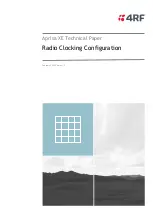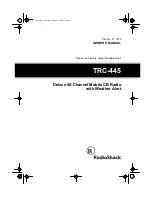
For your safety
11
■
United States Federal Communications Commission,
Code of Federal Regulations (CFR) Title 47 Parts 1.1307,
1.1310, and 2.1091.
■
American National Standards Institute (ANSI) / Institute
of Electrical and Electronic Engineers (IEEE) C95.1-1992.
■
Institute of Electrical and Electronic Engineers (IEEE)
C95.1-1999 Edition.
This radio complies with the IEEE and ICNIRP exposure limits
for occupational/controlled RF exposure environments at
operating duty factors of up to 50% talk to 50% listen.
Radio frequency emissions limits in the USA
Part 15 of the FCC Rules imposes RF emission limits on
receivers.
This radio complies with Part 15 of the FCC Rules. Operation
is subject to the condition that this device does not cause
harmful interference.
Frequency band reserved for distress beacons
Frequency band 406 to 406.1MHz is reserved for use by
distress beacons. Transmissions should not be made within
this frequency band.
Australia and New Zealand citizens band
(476.4 to 477.4MHz)
AS/NZS 4365 deals with the use of frequencies in the
476.425 to 477.400MHz band. Products capable of
operating in this band have been approved for operation in
the UHF Citizens Band Radio Service which is licensed in
Australia by the ACMA Radiocommunications (Citizens Band
Radio Stations) Class Licence and in New Zealand by the
MED General User Radio Licence for Citizens Band Radio.
Operation is subject to conditions contained within those
licences.
Repeaters operate by receiving a transmission on one
channel and re-transmitting it on another. Operators are
required to avoid using local repeater input channels, which











































